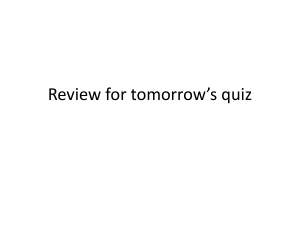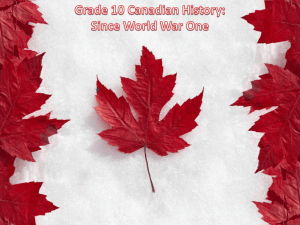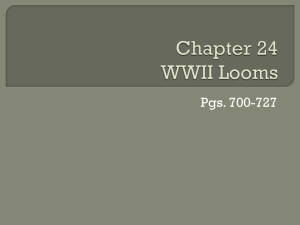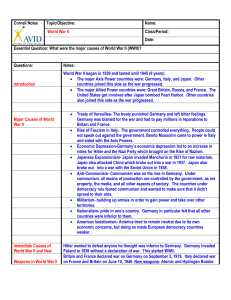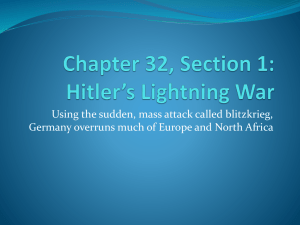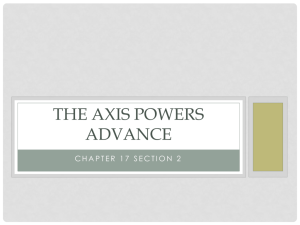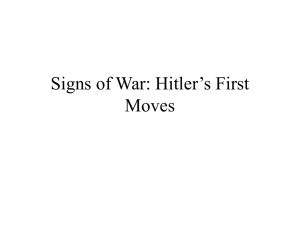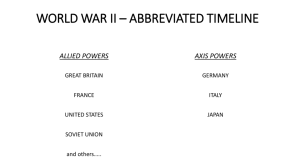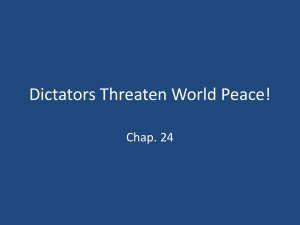CHAPTER 24 THE WORLD WAR LOOMS
advertisement
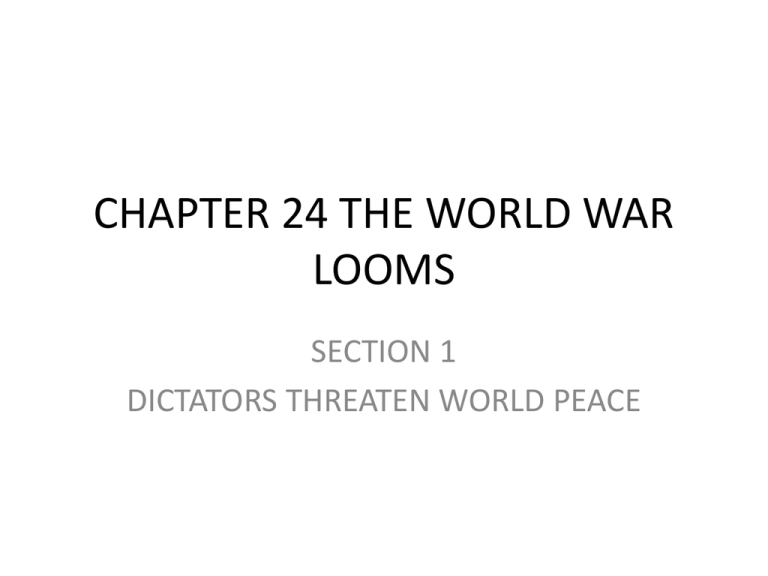
CHAPTER 24 THE WORLD WAR LOOMS SECTION 1 DICTATORS THREATEN WORLD PEACE Big Idea • The U.S. remains isolated from the world affairs as economic and political factors lead to the rise of nationalist/fascist/totalitarian leaders in the Soviet Union, Germany, Italy, Japan, and Spain. Europe after Treaty of Versailles Nationalism Grips Europe and Asia • The Failure of Versailles • Treaty of Versailles caused anger and resentment • Germans felt it wasn’t fair nor secure – they took the blame for the entire war and were stripped of overseas colonies and border territories • Problems not solved by Weimar Republic (democratic government in Germany postWWI) • With no democratic traditions, many countries turned to authoritarian leaders to solve social and economic problems • Joseph Stalin • Took over the Soviet Union (Communist) in 1924. • Agriculture and Industrial growth were economic goals • Abolished all privately owned farms. • 2nd Largest Industrial Power • 8-13 million people died Stalin’s Crimes • Mass Starvation – Tens of Millions • Mass Murder (Purges) – 500,000-1 million Communism • A theory or system of social organization based on the holding of all property in common • Actual ownership belongs to community or state • Francisco Franco • Spanish General, who repelled against Spanish republic. Civil War broke out. 500,000 people died. Franco gains victory in 1939. Became Spain’s fascist dictator. • Totalitarian • Benito Mussolini • Government with complete control over citizens. Individuals have no rights. • Took control in Italy. Great speaker and appealed to the people as a strong leader. • Fascism • Black Shirts • Il Duce • Stressed nationalism and placed the interests of the state above those individuals. • Thousands of supporters who marched to Rome • Mussolini called himself Il Duce or “the leader” he achieved efficiency but crushed all opposition making Italy a totalitarian state Adolf Hitler Facts • WWI veteran • Leader of the Nationalist Socialist Party • Nazis for short • Became Chancellor in Germany in 1933 • Installed brutal dictatorship • Adolf Hitler • Nazism • Jobless soldier after WWI. Quickly became a leader due to his powerful speeches. • the German brand of fascism, was based on extreme nationalism and racism. • Racial Purification • Inferior races (Untermensch) • Chancellor (prime minister) • Germans & Aryans (blue eyed, blond haired) should be master race. • Jews, Slavs, & all nonwhites were to serve the Aryans • Appointed in 1933, dismantled the democratic Weimar Republic. Create more living space. • Japan • Military leaders shared Hitler’s belief in needing more living space. Seized control of Manchuria (Chinese province) in 1931. • League of Nations • Condemned Japan, but no action taken. Japan drops out. • Germany • Pulls out in 1933. • 1935, builds up military (violation of the Treaty of Versailles) • 1936, sent troops into Rhineland (demilitarized zone) • Italy • 1936 invaded Ethiopia, independent African country. The United States Responds Cautiously • • • • Neutrality Acts 1935 1936 1937 • first two acts outlawed arms sales or loans to nations at war. Third act extended the ban on arms sales and loans to nations engaged in civil wars. • FDR reacts • Japan launches new attack on China in 1937 • Sent arms and supplies to China cause War was not declared on China. • FDR met with a lot of criticism because of his actions of trying to lead country into a war. SECTION 2 WAR IN EUROPE AUSTRIA AND CZECHOSLAVAKIA FALL • Austria • Sudetenland • German troops march into Austria unopposed on March 12, 1938. Majority of 6 million people were German • Western border region of Czechoslovakia. • Neville Chamberlain • Munich Agreement • British prime minister met with Hitler along with French premier. • Promised to protect Czechoslovakia. • September 30, 1938Sudetenland over to Germany without a single shot • Hitler said it would be last territorial demand • Winston Churchill • Appeasement • Chamberlain’s political rival was not happy about Munich agreement. • Giving up principles to pacify an aggressor. The German Offensive Begins • Czechoslovakia • Poland • March 15, 1939, Germany takes over rest of country. • Large German speaking population, eastern neighbor of Soviet Union, aided by France and Britain • Nonaggression pact • Germany & Soviet Union agree not to attack one another. Also decided to divide Poland between them. • Blitzkrieg • Lightning War. Fast tanks, powerful aircraft. Surprise and quickly crush the enemy. September 1, 1939 in Poland. 2 Days later France & Britain declare war. • Phony War • Next • 3 weeks and Poland ceased to exist. WWII had begun. • French & British troops sit on Maginot Line staring at Germans, German troops sit at the Siegfried Line staring back • By April 9, 1940, Denmark, Norway, Netherlands, Belgium & Luxembourg France and Britain Fight on • Fall of France • Charles de Gaulle • June 22, 1940, with help from Italy as they attacked from the south. • French general, fled to England. Set up a government in exile. • Battle of Britain • 2,000 German planes bomb London for 2 weeks straight • Britain used a Radar system to shoot down planes. 185 on Sept 15 of 1940, • Hitler calls off invasion • Both countries continue to bomb one another. SECTION 3 THE HOLOCAUST THE PERSECUTION BEGINS • April 7, 1933 • Hitler orders all “non Aryans” be removed from government jobs. This is first the move against Jews • Holocaust • 11 million people across Europe killed, more than half were Jews • Scapegoat • Nuremberg Laws • Star of David • Jews were blamed for all the problems that Germany had (economy & WWI) • 1935, stripped Jews from citizenship, jobs, & property • Jews had to wear this bright yellow star on clothes so they can be identified • Kristallnacht • November 9-10, 1938, Nazi troops attacked Jewish businesses, homes, & synagogues across Germany. • 100 killed, hundreds injured, 30,000 arrested, hundred of synagogues were burned • Nazi’s blamed Jews for the destruction • Refugees • • • • • Ship of St. Louis • German ocean liner with 943 passengers. Coast Guard prevented ship from docking in Miami and was forced back to Europe France 40,000 Britain 80,000 Palestine 30,000 U.S. 100,000 HITLER’S “FINAL SOLUTION” • Genocide • In 1939, a deliberate & systematic killing of an entire population. Only ¼ of Jews left in Germany, but millions more in territories occupied by Hitler • Enemies of the state • Gypsies- Inferior race • Freemasons- supporters of the Jewish conspiracy to rule the world • Jehovah’s Witnessesrefused to join German army and salute Hitler • Germans- homosexuals, mentally ill, physically disabled, & incurably ill • Nazi Death Squads • Hitler’s elite Nazi “security squandrons (SS)” rounded up jews in Poland and shot them on the spot. • Ghettos • Jews sent into overcrowded cities in Poland; barbed wire & stone walls • Concentration camps • Warehouse for undesirable • Hunger, humiliation, work that almost always ended in death • Overcrowded barracks shared meager meals. • Inmates worked dawn to dusk, 7 days a week till they collapsed. • Those who were weak were killed. THE FINAL STAGE • Poison Gas • Built 6 death camps in Poland • Each camp had several huge gas chambers in which 12,000 people could be killed a day AUSCHWITZ • Auschwitz • Prisoners separated into 2 groups (workers & would be killed) • Belongings left behind and would get later • Group that was being killed was led to gas chamber, told they were going to shower and handed a bar of soap each • Cyanide Gas • Used to kill the inmates while cheerful music played. • Some were buried in mass graves • Crematoriums were used at some camps as well to burn the dead and living • 6 million Jews died in the death camps SECTION 4 AMERICA MOVES TOWARD WAR U.S. MUSTERS ITS FORCES • Cash and Carry • Possibly too late • Sept. 1939, Roosevelt persuaded Congress to allow warring nations to buy U.S. arms as long as they paid cash and transported them in their own ships • France falls in summer of 1940 & Britain under attack • Axis Powers • Roosevelt Responds • Germany, Italy, & Japan (the Triparite Pact) sign a mutual defense treaty. • Each nation agreed to come to defense if either nation was attacked by U.S. • Sends Britain 500,000 rifles, 80,000 machine guns, traded 50 old destroyers for military bases in Caribbean and Newfoundland • Building U.S. defense • Congress increases spending on defense • Selective Training and Service Act- 16 million men between 21-35 were registered. 1 million drafted but for 1 year only in Western Hemisphere. • Roosevelt runs for 3rd Term • He wins 55% of the vote. Republican nominee Wendell Wilkie supported Roosevelt for aiding Britain. Very little difference so people chose who they already knew. “The Great Arsenal of Democracy” • Lend-Lease Plan • Late 1940, Britain had no more money for arsenal. Lend or Lease arms & other supplies to any country whose defense was vital to the United States. Isolationists once again against it but Congress passes it anyway in March of 1941. • Supporting Stalin • United States started to supply the Soviet Union after Hitler broke his agreement with Stalin and invaded the Soviet Union in June of 1941. • German Wolf Packs • U-boats & aircraft would sink ships carrying supplies. 350,000 tons in a single month. Roosevelt tells Navy to fire in self-defense. FDR PLANS FOR WAR • Extend the term of draftees • Roosevelt asking for more terms of the draftees because he knows war is close. House of Reps passes it but only by 1 vote. • Atlantic Charter • Roosevelt meets with Churchill. • Collective security • Disarmament • Self-determination • Economic cooperation • Freedom of the seas This charter became basis of a new document called “A declaration of the United Nations” • United Nations Allies against the Axis powers. 26 Nations signed it. • Shoot on Sight • Pink Star • U.S. destroyer Kearny • U.S. destroyer Reuben James • Navy to fire on German submarines on sight after U.S. destroyer Greer was fired on by German submarine • American Merchant ship sank off Greenland • Was torpedoed and 11 lives lost • Sank and more than 100 sailors killed JAPAN ATTACKS THE UNITED STATES • Hideki Tojo • Chief of staff of Japans Army, launched invasion into China. • Japan’s Goal • Wanted to unite East Asia under Japan. Took over Vietnam, Cambodia, Laos. • United States Protest • Peace talks • Cut trade off with Japan of embargoed goods, including oil. • Tojo promised the emperor to preserve peace with America but is preparing navy to attack. • Dec 6, 1941, Roosevelt received decoded message that Japan’s peace envoy to reject all American peace proposals • Pearl Harbor • Dec 7, 1941, early in the morning, Japanese warplanes struck. • 2,403 killed • 1,178 injured • 21 ships sunk or damaged including 8 battleships • 300 aircraft were damaged or destroyed • Greater losses than all of WWI • Reaction • Congress approves Roosevelt’s request to declare war on Japan the following day. • 3 days later, Germany and Italy declare war on U.S. • Isolationist • Supported an all out American effort.
